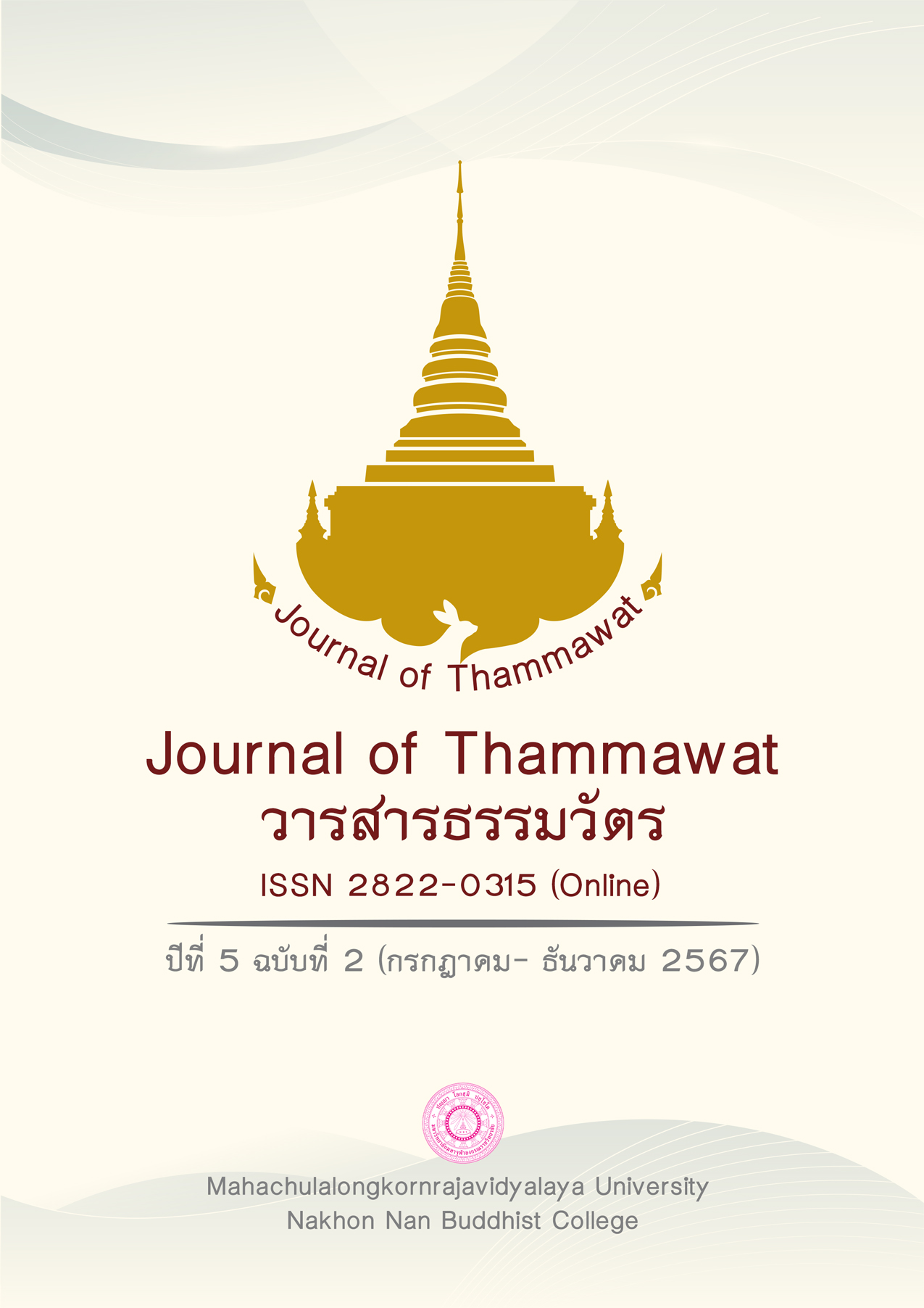Mind Empowerment through Vipassana Meditation Practicing Following the Approach of Luang Pu Thong Sirimongkhalo
Main Article Content
Abstract
The purpose of this article was: 1) to study Vipassana meditation, 2) to study the process of mind empowerment, 3) to analyze mind empowerment through Vipassana meditation practicing following the approach of Luang Pu Tong Sirimongalo. This was qualitative research, studying through documents and field by interviewing 25 key informants. Data were conducted and presented in narrative form.
The results revealed that: 1) Vipassana meditation practicing had Principles and practices according to the Tripitaka, Commentaries, and Pakaranavises. It aligned with the practices of Theravada Buddhism, 2) The process of mind empowerment was a single systematic path, teaching and test emotions individually, 3) The primary point for analysis of mind empowerment was mental empowerment. The practitioners could develop mind empowerment by themselves, having more senses and stronger mind. For the secondary points, there were six of them: (1) Mental empowerment through the Balas: it was found that the most of practitioners were led by faith which was then followed by preservance, mindfulness, concentration and wisdom; (2) expectation on the practicing: it was found that most of the practitioners expected happiness and peace; (3) methods and experience of practicing: for the methods, they used perseverance on observing their bodies, feelings, mind, and mental objects. For the experience of the practicing, it was varied in terms of physical, mental, emotional, and intellectual health; (4) mental empowerment’s effect on physical and mental health, it helped cure some diseases and enhanced energy and strength. For the mental health, it enhanced mental strength and empowerment; (5) practicing application in practice: the practitioners applied the experience of practicing in daily lives, at work, as well as in studying, bringing in good results for themselves and the societies; (6) attitude towards the practicing: the practitioners had great attitudes, happiness, peace and mind power.
Article Details

This work is licensed under a Creative Commons Attribution-NonCommercial-NoDerivatives 4.0 International License.
References
กรมอนามัย. (2566). สรุปสถิติทั่วโลก รายงานสถานการณ์โควิด-19 ทั่วโลก. ค้นเมื่อ 4 สิงหาคม 2566.
จาก https://covid19.anamai.moph.go.th/en/.
คณะศิษยานุศิษย์ หลวงปู่ทอง สิริมงคโล. (2565). ทางสายเอก. (พิมพ์ครั้งที่ 8). เชียงใหม่: ดาราวรรณการพิมพ์.
คณาจารย์ มหาวิทยาลัยมหาจุฬาลงกรณราชวิทยาลัย. (2560). พระพุทธศาสนากับวิทยาศาสตร์. พระนครศรีอยุธยา: โรงพิมพ์มหาจุฬาลงกรณราชวิทยาลัย.
พระปลัดสมภาร สมภาโร (ทวีรัตน์). (2564). การปฏิบัติวิปัสสนากัมมัฏฐานที่ส่งผลต่อการพัฒนาสุขภาพจิตของบุคคล. (ดุษฎีนิพนธ์พุทธศาสตรดุษฎีบัณฑิต สาขาวิชาพระพุทธศาสนา). บัณฑิตวิทยาลัย: มหาวิทยาลัยมหาจุฬาลงกรณราชวิทยาลัย.
พระพยุง เมธาวี (สืบสำราญ). (2560). การวิจัยประยุกต์ใช้วิปัสสนากัมมัฏฐานของวัดราษฎร์บำรุงหนองลี ตำบลโพทะเล อำเภอค่ายบางระจัน จังหวัดสิงห์บุรี. (ดุษฎีนิพนธ์พุทธศาสตร์มหาบัณฑิต สาขาวิชาพระพุทธศาสนา). บัณฑิตวิทยาลัย: มหาวิทยาลัยมหาจุฬาลงกรณราชวิทยาลัย.
พระพรหมมงคล, วิ. (พระอาจารย์ทอง สิริมงคโล). (2565). คู่มือปฏิบัติวิปัสสนากรรมฐานในแนวสติปัฏฐาน 4. เชียงใหม่: ดาราวรรณการพิมพ์.
พระมหาอนันต์ อนุตฺตโร และคณะ. (2564). การปฏิบัติกัมมัฏฐาน เพื่อบำบัดความเครียด. วารสารมนุษยศาสตร์และสังคมศาสตร์ มหาวิทยาลัยเอเชียอาคเนย์, 5(2), 329-342.
มหาจุฬาลงกรณราชวิทยาลัย. (2539). พระไตรปิฎกภาษาไทย ฉบับมหาจุฬาลงกรณราชวิทยาลัย. กรุงเทพฯ: โรงพิมพ์มหาจุฬาลงกรณราชวิทยาลัย.
ส. มหาปัญโญภิกขุ. (2556). ฝึกใจให้รู้แจ้งตามหลักสติปัฏฐาน. (พิมพ์ครั้งที่ 2). กรุงเทพฯ: วาย เอ็ม ครีเอทีฟ.
สมเด็จพระพุทธโฆษาจารย์ (ป.อ. ปยุตโต). (2562). พุทธธรรม ฉบับปรับขยาย. (พิมพ์ครั้งที่ 51). กรุงเทพฯ: มูลนิธิพุทธธรรม.
สุภีร์ ทุมทอง. (2558). อินทรีย์ 5 พละ 5 (ชุดโพธิปักขิยธรรม). นนทบุรี: ภาพพิมพ์.
Daphne M. Davis, Ph.D. & Jeffrey A. Hayes, Ph.D. (2012). What are the benefits of mind-fulness. American Psychology Association, 43(7), 64-79.


